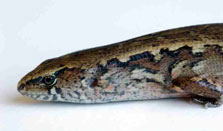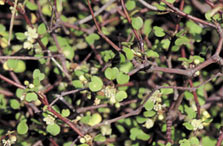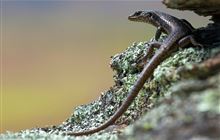Attract lizards to gardens in the lower North Island
Introduction
Gardeners in the lower North Island can make a difference by creating habitats for lizards to flourish.Some lizards happily alongside us without our knowing, others are declining due to loss and fragmentation of habitat, and predation by cats, birds and mammals. Every gardener can make a difference by creating habitats for lizards to flourish.
Lizards of urban areas in the lower North Island
Common skink (Oligosoma polychroma)
Common; around much of the Wellington region.
Gardening for the common skink (PDF, 373K)
Brown skink (Oligosoma zelandicum)
Scattered throughout Wellington from Johnsonville to Karori and south to Island Bay. Not abundant.

Ornate skink
Copper skink (Oligosoma aeneum)
A handful of records exist for Wellington, Hutt Valley and east of the harbour.
Ornate skink (Oligosoma ornata)
There are few records in Wellington but they are known to be locally abundant in some areas including from a line across central Wellington to Karori north, and through most suburbs to Johnsonville (south of State Highway 1).
Gardening for the ornate skink (PDF, 569K)
Common gecko (Hoplodactylus maculatus)
Widespread; scattered along the southern coast including inland on the old coastal scarps.
Gardening for the common gecko (PDF, 491K)
Marlborough mini (H. “Marlborough mini”)
A coastal species, similar in appearance to common geckos. Only recently identified and found between Houghton Bay and Sinclair Head.
Spotted skink (Oligosoma lineoocellatum)
Previously found near Percy’s Reserve, Korokoro, Wainuiomata Coast, to Turakirae Head. It is not clear whether any of these populations still exist.
Southern North Island forest gecko (H. “southern North Island”)
Little is known about its distribution but especially found in the forested hill country throughout Wellington
Southern North Island forest gecko (PDF, 472K)
Wellington green gecko (Naultinus elegans punctatus)
Found in most suburbs of Wellington city, Petone, Lower and Upper Hutt, especially in forested areas. A few records from Tawa, Haywards, Whitby and Judgeford.
Gardening for the Wellington green gecko (PDF, 444K)
Plants that lizards love
Divaricating shrubs for complexity and height

Shrubby tororaro
Small-leaved pohuehue, scrub pohuehue (Muehlenbeckia complexa); shrubby tororaro (Muehlenbeckia astonii); thick-leaved mahoe (Melicytus crassifolius)
Species to give protection from predators
Matagouri (Discaria toumatou); speargrass (Aciphylla squarrosa); shrubby tororaro (Muehlenbeckia astonii)
Vines to connect habitats
New Zealand clematis (Clematis foetida, C. paniculata, C. forsteri) Kaihua, New Zealand jasmine (Parsonsia capsularis, P. heterophylla) Climbing rātā (Metrosideros perforata, M. fulgens)
Thick ground covers for retreat sites
Ferns (Asplenium, Blechnum, Adiantum, Doodia species), tussock grasses and sedges (Carex, Chionochloa, Poa, Festuca species), rengarenga (Arthropodium cirratum) pinatoro, New Zealand daphne (Pimelia prostrata, P. arenaria) Shore spurge (Euphorbia glauca), fuchsia (Fuchsia perscandens)
Clump forming species to create debris
Flax (Phormium tenax or P. cookianum), cabbage tree (Cordyline australis), pukio or swamp sedge (Carex virgata), astelia (Astelia fragrans, A. grandis, A. solandri)
Food species
Nectar: Rātā species (Metrosideros robusta, M. fulgens), flax (Phormium tenax, P. cookianum), mänuka (Leptospermum scoparium), koromiko (Hebe stricta var. atkinsonii)
Fruit: Kawakawa (Macropiper excelsum), coprosma species (e.g., Coprosma repens, C. propinqua), porcupine shrub (Melicytus crassifolius), small-leaved pohuehue, (Muehlenbeckia complexa), nikau (Rhopalostylis sapida) (pollen)

